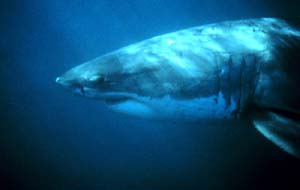| NOAA Magazine || NOAA Home Page |
NOAA
PARTNERS WITH U.S. FISH AND WILDLIFE SERVICE
TO HELP SHARKS KEEP THEIR FINS
 July
5, 2007 — NOAA and the U.S.
Fish and Wildlife Service have joined forces to expand their ability
to analyze dried shark fins and identify the species from which they
were removed. This new partnership will support efforts to curtail shark
finning, the practice of removing a shark’s fins at sea and throwing
the carcass overboard. Shark finning is prohibited in federal waters
of the Atlantic and Pacific oceans, the Gulf of Mexico and the Caribbean
Sea. (Click NOAA image for larger view of NOAA Office of Law
Enforcement agent counting agger shark fins. Please credit “NOAA.”)
July
5, 2007 — NOAA and the U.S.
Fish and Wildlife Service have joined forces to expand their ability
to analyze dried shark fins and identify the species from which they
were removed. This new partnership will support efforts to curtail shark
finning, the practice of removing a shark’s fins at sea and throwing
the carcass overboard. Shark finning is prohibited in federal waters
of the Atlantic and Pacific oceans, the Gulf of Mexico and the Caribbean
Sea. (Click NOAA image for larger view of NOAA Office of Law
Enforcement agent counting agger shark fins. Please credit “NOAA.”)
“NOAA is pleased to partner with the U.S. Fish and Wildlife Service in this effort to promote the protection and conservation of marine resources,” said John H. Dunnigan, NOAA’s assistant administrator for the National Ocean Service. “This new collaboration will greatly improve our ability to aid law enforcement in determining whether protected shark species are being harvested for fins.”
Shark fins are dried for use in shark fin soup, considered an Asian delicacy, making fins the most valuable part of a shark. The soup can sell for $100 dollars a bowl or more in some restaurants. Shark finning is a growing concern as worldwide fishing pressure increases and scientists learn more about the biology of these long-lived, slow-to-reproduce species.
Though fishermen cannot legally discard finned carcasses at sea, they are allowed to possess cut fins as long as the fins make up no more than five percent of the weight of the carcasses on board. The species of sharks with the most valuable fins are not always the same as the shark species with the most valuable meat.
The discrepancy between the value of fins and carcasses can lead to deceitful fishing practices. In some instances, landed fins and carcasses were found to be from different species, indicating that some fins were removed illegally and the corresponding carcasses were discarded at sea.
 NOAA
researchers developed the currently-used method for shark species identification,
which uses DNA to distinguish the most common and commercially important
35 of the 73 species in U.S. waters. Without DNA testing, it can be
difficult to identify a shark’s species based on visual inspection
of its fin, especially after it has been dried for use in soup.
(Click NOAA image for larger view of White Shark off the California
coast. Click here for high resolution
version, which is a large file. Please credit “NOAA.”)
NOAA
researchers developed the currently-used method for shark species identification,
which uses DNA to distinguish the most common and commercially important
35 of the 73 species in U.S. waters. Without DNA testing, it can be
difficult to identify a shark’s species based on visual inspection
of its fin, especially after it has been dried for use in soup.
(Click NOAA image for larger view of White Shark off the California
coast. Click here for high resolution
version, which is a large file. Please credit “NOAA.”)
“Working together, NOAA and the U.S. Fish and Wildlife Service will be able to increase the efficiency and speed with which shark fin samples can be analyzed to determine the source species,” said Katherine Moore, a marine biologist with the NOAA National Centers for Coastal Ocean Science.
The shark fin identification research will be performed by the NOAA Center for Coastal Environmental Health and Biomolecular Research in Charleston, S.C., which is one of the NOAA National Centers for Coastal Ocean Science, and by the USFWS National Fish and Wildlife Forensics Laboratory in Ashland, Ore.
NOAA, an agency of the U.S. Commerce Department, is celebrating 200 years of science and service to the nation. From the establishment of the Survey of the Coast in 1807 by Thomas Jefferson to the formation of the Weather Bureau and the Commission of Fish and Fisheries in the 1870s, much of America's scientific heritage is rooted in NOAA.
NOAA is dedicated to enhancing economic security and national safety through the prediction and research of weather and climate-related events and information service delivery for transportation, and by providing environmental stewardship of our nation's coastal and marine resources. Through the emerging Global Earth Observation System of Systems (GEOSS), NOAA is working with its federal partners, more than 60 countries and the European Commission to develop a global monitoring network that is as integrated as the planet it observes, predicts and protects.
Relevant Web Sites
NOAA
NOAA Center for Coastal Environmental Health and Biomolecular Research
USFWS National Fish and Wildlife Forensics Laboratory
Media
Contact:
Ben
Sherman and David Hall,
NOAA Ocean Service,
(301) 713-3066